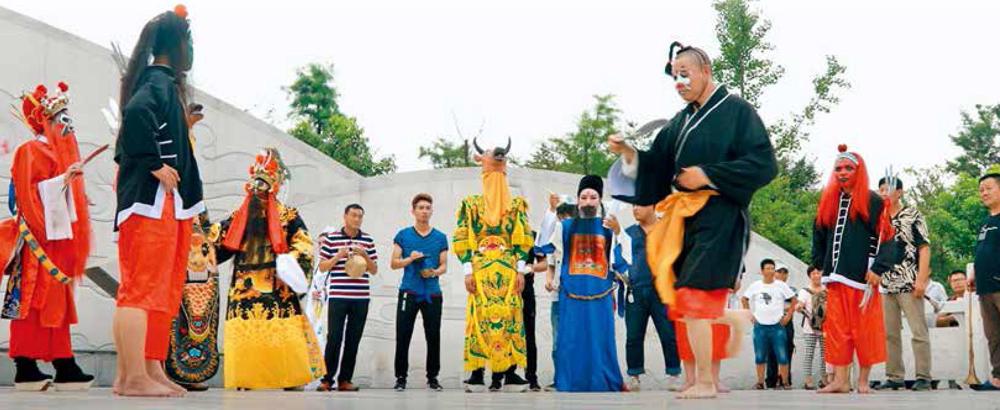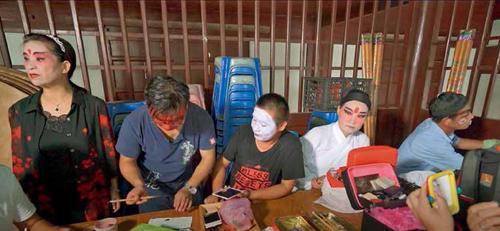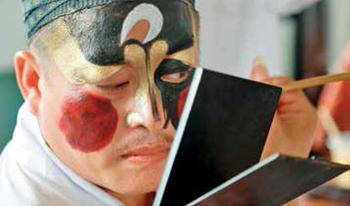寻迹哑目连
周琼?胡雅洁



上虞哑目连和杭州西溪哑目连,是一起被列入浙江省非物质文化遗产名录的。根据《东京梦华录》中对哑杂剧的描写,可以看出哑目连这种古老而典型的民间哑剧形式,其实有着北宋勾栏“哑杂剧”的遗踪。
“台上一声啼,台下千人泪;台上一声笑,台下万人欢”,这句古老的谚语,道出了中国戏剧诉不尽的情怀往事。而在中国戏剧长河中有这样一种独特的戏剧存在,它没有一句唱腔和对白,配以独一无二的乐器招军(),它就是“哑目连”,已列入浙江省省级非物质文化遗产项目。
兴盛之地在上虞
在炸雷一样响的锣鼓声中,乐师吹起招军,附近的乡民渐渐聚拢往台前观看,竟看得入神,于是想来,儿孙忤逆、邻里是非、善恶功过都如正在上演的戏剧一般,按下去孟浪狭邪,浮上来忠孝节义。最后,且惊且惧、且笑且叹的哑目连在一片叫好声中散场。
追溯哑目连的兴盛之地当属浙江省绍兴市上虞区,自秦王嬴政设县以来,上虞已有两千多年历史。而在这片土地孕育而生的“哑目连”,更是有着一千多年的文化积淀。《送夜头》则是当地人最熟悉的一幕哑目连经典剧目,讲的是夜头被无常戏弄的滑稽场景。身为家丁的夜头,带着酒菜饭去坟头祭祀,途中用酒杯接酒喝,却总是被无常半途偷喝了去,于是便就着壶嘴喝,喝不到酒的无常气得拿起芭蕉扇扇在夜头的头上,夜头吓得连忙丢了酒壶对着周围挥舞拳头,接着又坐下来吃粉条,夜头吃这头,无常吃着另一头,这一人一鬼、一明一暗,相互辉映,煞是好笑。
其实在古时,人们大多有所信仰,倘若家中不幸有人去世,家里便会派遣夜头用酒饭去恭送,让去世的亲人获得安宁。人们实则是通过表演来祈求平安,宣扬因果报应、惩恶扬善的观念,通过哑目连形成精神寄托。哑目连在民间有着浓厚的信仰根基,然而一度兴盛不衰的哑目连在发展过程中也历经多番波折。
沿袭自传统的目连戏
哑目连是目连戏的分支,所以追溯哑目连的历史,应当先探寻目连戏。
公元3世纪,大约在西晋初年,《佛说盂兰盆经》传入中国,述说了目连为救地狱中罪孽深重的母亲,聚十方僧众之力使其解脫的故事。而后,南朝佛教大兴流布,盂兰盆节也随之广为传播。初唐,佛家用梵呗、唱导的方式将庄严雍容的经文传扬开来,后演化成以唱为主、曲白相生的变文,使目连救母这一故事在当时家喻户晓。目连戏在南宋初年,以杂剧的形式变为戏文,在宋、元、明、清四朝始终与宗教祭祀以及原始民俗相结合,目连戏的文本不断被修饰和丰富,但是目连救母的主干却始终未变。
随着宋室南迁,“路岐人”带着诸般曲艺杂耍南下,南方在村坊小技的基础上吸收了杂剧等其他各种技艺的精华,从而形成南戏——即温州杂剧。在此北南汇通、风俗交融的时代背景下,目连救母的戏文脱胎而出。
路岐人将这种已成形的戏文自温州带至杭绍各地,并远播南方腹地,在安徽、湖南、江苏、江西、福建、四川、广东、云南等省均有分布,种类之多,声腔之繁,难以胜数。
目连戏旧时在浙江流行甚广,最兴旺的地区则是在绍兴。从目连戏的历史渊源管窥,绍兴目连戏是南戏的遗存。绍兴文人雅士居多,从而为戏曲文化的生长提供了不竭动力。除绍兴、温州外,目连戏还覆盖了现在的杭州淳安、临安昌化、衢州、开化、东阳等地,几乎浙江全省都有目连戏活跃的身影。
除此之外,根据《东京梦华录》中描写哑杂剧的艺人“金睛白面,如髑髅状,系锦绣围肚看带,手执软杖,各作魁谐趋跄”中,还可以看出哑目连这种古老而典型的民间哑剧形式,其实也有着北宋勾栏“哑杂剧”的遗踪。古时,哑杂剧在绍兴上虞的北部崧厦、沥海、沥东、南湖一带流传甚广。如今,它已经在历史的洪流中消逝,独留存哑目连。
从宗教剧转化到戏剧
哑目连的内容与目连戏相同,在表演时,绝大多数演员被要求赤脚出场,穿半长红裤,凭身段、手势、步伐、神情,外加节奏井然的配乐以完成表演。
哑目连承载内容的形式由于演出规模和场地的不同,主要分为两类:一是迎神赛会路上,各家戏班各显神通,《请无常》《捉刘氏》等轮番上演,即“落地哑目连”;二是在庙堂草台上表演,则称为“上台哑目连”。表演哑目连的戏班则被称为“太平会”,在清末至民国初,上虞最具盛名的还属“南湖太平会”。而上虞是吴越之地,禁忌繁多,在哑目连的发展过程中留下了可追寻的遗存。
电视纪录片《南宋》里说,“孝宗乾道三年,临安和会稽都有演出,杭州老和山下东岳庙的傩戏在清初最盛”,这里提及的傩戏,就是哑目连。人们在祭祀时跳起傩舞来逐鬼除疫,寻求平安康乐。在其后的发展历程中,傩戏完成了从宗教剧到戏剧的转化,而哑目连作为古老傩戏的遗存也受到了影响,演员以油彩涂面代替了原本的面具,用以模仿鬼神,用充满张力的动作取代了武功演示。比如,鲁迅先生笔下的无常头戴高帽三尺,身穿白布一匹,脚踏草鞋一只,身束丝条一根,项挂银锭一朵,手拿芭蕉扇一把。
传承坚持中寻找未来
20个世纪80年代,全国文化系统开展了“民间文艺三大集成”工程,约有二十多处哑目连留存得到挖掘。
1985年,上虞召集了数十名老艺人进行抢救性保护,整理出《阎王发牌》《请无常》《捉刘氏》《夜牌渡河》《送夜头》《男吊》《女吊》等二十余场戏。至此,哑目连重新出现在人们的视野中。
2007年,上虞哑目连和杭州西溪哑目连一起被列入浙江省非物质文化遗产名录,给哑目连的传承带来了曙光。
娄素芬,上虞东关人,现哑目连上虞传承人,师承非遗传人赵海富。当地的传统文化研究者王关明这样评价她:“娄素芬家族是民间艺术之家,包括她爷爷和爸爸,都有这方面的天赋。”最开始王关明找的是娄素芬的哥哥娄卫铨,希望他能传承哑目连。娄卫铨去世后,娄素芬接过传承重担。从2011年开始,她各方奔走,逐渐聚起一支复排队伍。8年的时间里,她与丈夫高伟海将哑目连从寥寥几场复排至十余出,将小戏班扩展至30多人。
西溪哑目连的发展状况与上虞区一样,早几十年经历困境,2014年2月,随着最后一位传承人郑友文的离世,濒临失传。
同年,相關部门展开了围绕西溪哑目连的保护工作,包括走访西溪文化研究者郑发楚,获得文献等相关资料;邀请浙江省京剧团的专家朱幼琪、谈家治担任技术指导,在社区内组建志愿者团队复排哑目连。志愿者既包括年逾古稀的郑发洵老先生,也有70后、80后的志愿者,众人一周四次齐聚在社区活动中心,敲碎了无数面练习的铜锣,终于将这门古老的技艺送上舞台。
Pantomime Mulian Show in Shaoxing
By Zhou Qiong, Hu Yajie
Shaoxing in eastern Zhejiang is a city of history and culture. It would be a time-consuming task to explain its more-than-2,000-year history and cultural wealth. Take operas in Shaoxing for example. Yueju Opera that emerged in Shaoxing more than 100 years ago and took shape in Shanghai enjoys national popularity that is only second to Peking Opera. Shaoxing Opera, another opera genre popular in Shaoxing, presents a totally different performance style. And there is the unique Pantomime Mulian Show in Shaoxing.
Mulian Show is a unique opera genre in China. It is named after a person while all other folk operas and shows across the country are generally named after their respective regions. What makes the Mulian Show in Shaoxing unique is that it is a pantomime stunt while in other parts of the country Mulian Show performers speak lines and sing arias. The pantomime in Shaoxing doesnt have a single line and an aria for performers to speak and sing. The main musical instrument used in the opera is , a brass bugle occasionally used in folk music and, in ancient times, in the army. literally means “summon the army”. The whole pantomime show is accompanied by the bugle and percussion instruments.
All the Mulian Shows in China are named after . It is a popular Chinese Buddhist tale originating in the third century, inspired by tales from India of Maudgalyayana, who is named Mulian in Chinese stories. Mulian, a virtuous monk, seeks the help of the Buddha to rescue his mother, who has been condemned to the lowest and most painful purgatory in karmic retribution for her transgressions. Mulian cannot rescue her by his individual effort, however, but is instructed by the Buddha to offer food and gifts to monks and monasteries on the fifteenth day of the seventh lunar month, which established the Ghost Festival. The monk's devotion to his mother reassured Chinese that Buddhism did not undermine the Confucian value of filial piety and helped to make Buddhism into a Chinese religion.
To be more accurate, the opera was named after the tale. Such a designation is the only one of its kind in Chinas history of theater. The Mulian Opera was brought south after the Southern Song (1127-1279) established itself in Hangzhou. The performance spread to the southeast and southwest of China. In the far-reaching dissemination, the tale evolved and appeared in various forms and performers sang different melodies in different styles and spoke different lines.
The Mulian Opera was popular in Zhejiang in general and in Shaoxing, home to a lot of scholars and well educated people, in particular. Scholars agree that the Pantomime Mulian Opera is partly what remains from the ancient South Opera which originated in the Southern Song Dynasty and fathered many regional operas and that it retains some influences of the pantomime shows in Hangzhou in the Southern Song Dynasty. Pantomime shows prospered for a long while in Shaoxing. Today, only the Pantomime Mulian Opera remains in some places in Shangyu, which used to be a rural county and now a district of Shaoxing.
The Pantomime Mulian Opera shares essentials with Mulian shows across the country. Actors are barefooted on the stage. They wear knee-length pants in red. The difference is that in Shaoxing actors pantomime. The pantomime show is divided into two categories: street performances and theater performances. In a first-category show, performers join a procession marching through streets in special folk ceremonies and festivals. In the second category, pantomime artists perform on a village stage. As the opera evolved, artists had their faces painted heavily.
The Pantomime Mulian Opera shows went out of favor after 1949. Gradually, troupes got disorganized. In the early 1980s, a nationwide preservation project was launched to rescue so-called outmoded folk shows. In 1985, dozens of pantomime show artists in Shangyu were summoned and their shows were videotaped. About 20 plays were taped and submitted to the Ministry of Culture. In 2007, the Pantomime Mulian Opera of Shaoxing was listed as a provincial cultural heritage. This inscription has given the very push the Pantomime Mulian Opera needs for survival.
However, it is a challenge to carry the pantomime show forward. Lou Sufen in Shangyu is now the designated master of Pantomime Mulian Show in Shangyu. She is from a family of Taoists. Zhao Haichuan, a master of intangible cultural heritage, is her tutor. She has been performing the pantomime for a long time. Her grandfather and father were pantomime artists. At first, the local cultural authorities wanted to appoint her older brother as the designated master. He passed away. Since she became the master in 2011, Lou Sufen has been promoting the folk art. Over the past eight years, she has worked in partnership with her husband. The troupe the couple founded has over 30 members. And nowadays they can stage over 10 different shows.
——弋阳腔艺术保护中心演出

